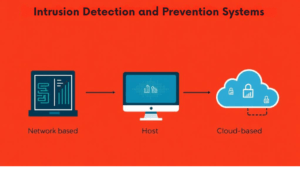Why Intrusion Detection and Prevention Systems (IDPS) are Essential for Cybersecurity
Intrusion Detection Prevention Systems (IDPS) are essential for safeguarding your network and systems against malicious activities. They continuously monitor traffic and system activities, employing both signature-based and anomaly-based detection methods to identify threats in real time. When a potential threat is detected, IDPS can automatically take actions like blocking malicious traffic, greatly enhancing your security posture. With various types, such as network-based and host-based systems, each serves a unique purpose. Automation further boosts their efficiency, reducing human error and improving response times. There’s much more to explore about how IDPS can protect your digital environment effectively.
Key Takeaways
- Intrusion Detection Prevention Systems (IDPS) are vital for real-time threat monitoring and network protection.
- IDPS use both signature-based and anomaly-based detection to identify known and emerging threats.
- Different types of IDPS (network-based, host-based, wireless) safeguard various aspects of your digital environment.
- Automation in IDPS enhances efficiency, reduces human error, and accelerates response times.
- Integrating IDPS into your cybersecurity framework significantly boosts your organization’s security posture.
Definition of IDPS
An Intrusion Detection Prevention System (IDPS) serves as an essential security solution that continuously monitors both network and system activities for signs of malicious behavior or policy violations.
It combines the functionalities of Intrusion Detection Systems (IDS) and Intrusion Prevention Systems (IPS) to detect threats and actively block unauthorized access.
By employing signature-based detection methodologies, the IDPS can effectively identify known threats, while also providing real-time monitoring to catch emerging security incidents.
This proactive approach helps guarantee your organization’s sensitive data and technology infrastructure remain secure.
Continuous updates are crucial, as they enable the IDPS to adapt to evolving threats and maintain accurate detection capabilities, guaranteeing robust protection against potential cyber-attacks.
How IDPS Operates

Operating continuously, Intrusion Detection Prevention Systems (IDPS) monitor network traffic and system activities to swiftly identify and respond to potential security threats.
Utilizing both signature-based and anomaly-based detection methodologies, these systems effectively distinguish between known threats and deviations from normal behavior. When a potential threat is detected, an IDPS can automatically take preventative actions, such as blocking malicious traffic or terminating suspicious sessions, greatly enhancing your organization’s security posture.
Additionally, IDPS logs incidents and integrates with Security Information and Event Management (SIEM) systems, offering valuable data for security analysis and compliance. This interconnected approach fosters a more robust defense against intrusions, ensuring that you remain vigilant in an increasingly complex digital landscape.
Types of IDPS

While understanding the various types of Intrusion Detection Prevention Systems (IDPS) is essential for effective cybersecurity, it’s important to recognize how each type serves a unique purpose in safeguarding networks and systems.
Network-based intrusion prevention systems (NIPS) monitor entire networks, analyzing packets to identify malicious traffic in real-time.
Host-based intrusion prevention systems (HIPS) focus on individual endpoints, scrutinizing system activity for suspicious behavior.
Wireless intrusion prevention systems (WIPS) secure wireless networks, detecting unauthorized access points.
Network behavior analysis (NBA) enhances detection by identifying unusual traffic patterns that may signal security threats.
Benefits of IDPS

Enhancing your organization’s cybersecurity posture, Intrusion Detection Prevention Systems (IDPS) offer a multitude of benefits that are essential in today’s digital landscape. With continuous monitoring of network traffic, IDPS enables real-time detection and response to threats, improving your overall security posture. By automating threat detection and incident response, reliance on human oversight is reduced, minimizing risks and enhancing response times.
| Benefit | Description |
|---|---|
| Continuous Monitoring | Provides real-time detection of potential threats. |
| Threat Management | Integrates with security tools for a unified approach. |
| Anomaly-Based Detection | Identifies both known and unknown threats effectively. |
Role of Automation in IDPS

Automation plays a pivotal role in the effectiveness of Intrusion Detection Prevention Systems (IDPS) by greatly improving the speed and accuracy of threat detection and response.
By leveraging automation, IDPS can continuously analyze vast amounts of network traffic and system events, enhancing detection accuracy without human intervention. The integration of machine learning algorithms allows these systems to adapt to new patterns, improving their capabilities over time.
Automated alerting mechanisms guarantee that security teams receive timely notifications, enabling faster incident response and reducing breach risks.
In addition, automation enforces security policies consistently across the organization, minimizing human error and guaranteeing compliance with regulatory requirements.
Strengthening Your Digital Defense: The Critical Role of IDPS in Cybersecurity
Incorporating an Intrusion Detection Prevention System into your cybersecurity framework is like installing a high-tech security system in your home. Just as a smart alarm detects unusual movements and alerts you before a break-in occurs, IDPS monitors your network for suspicious activity, enabling you to respond swiftly. With the right IDPS in place, you greatly reduce your risk of cyber threats, protecting your digital assets and ensuring a safer environment for your organization’s operations.
Questions? We Have Answers.
Get answers to a list of the most Frequently Asked Questions.

Experienced cybersecurity analyst, software engineer, patent attorney, worked with Linux, Windows, AWS, lots of security tools. Hope to help people do the right things and do the things right!

